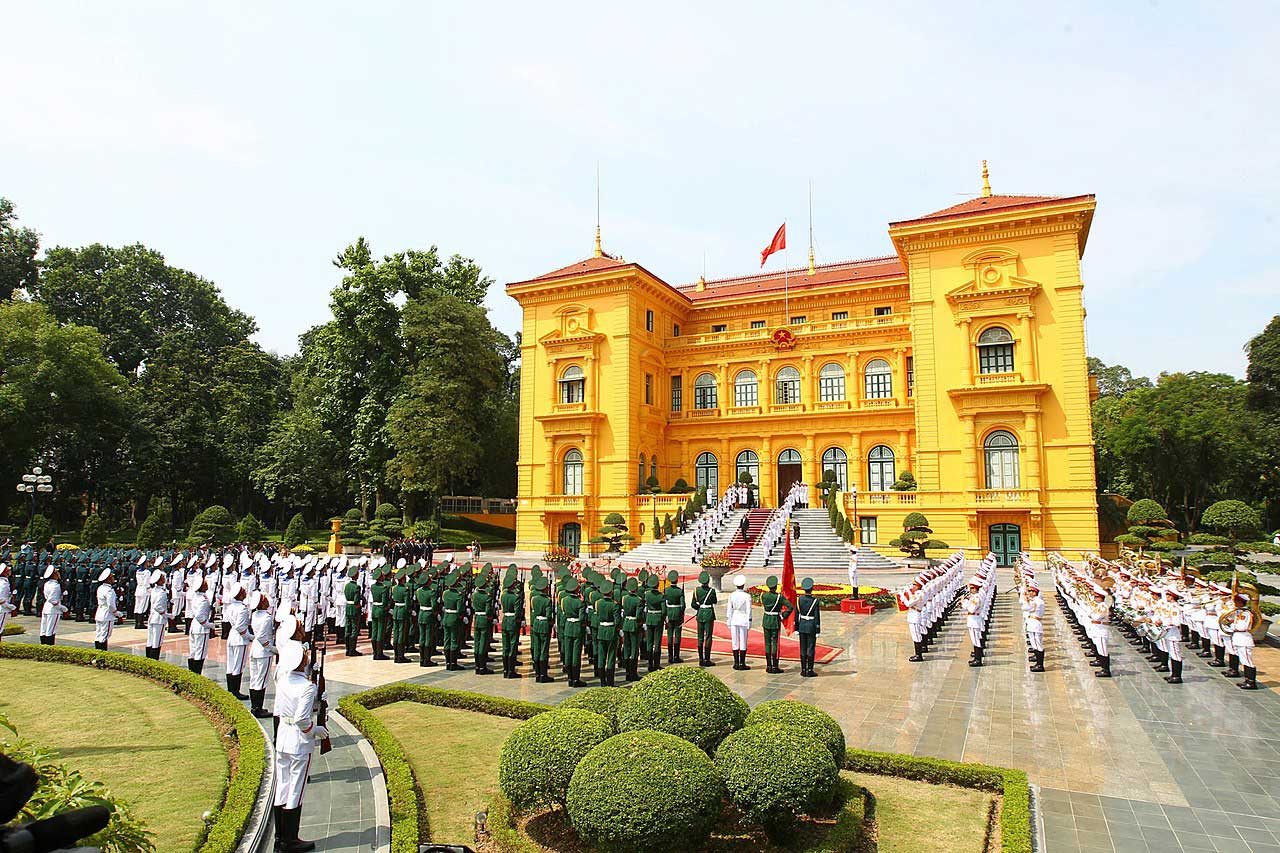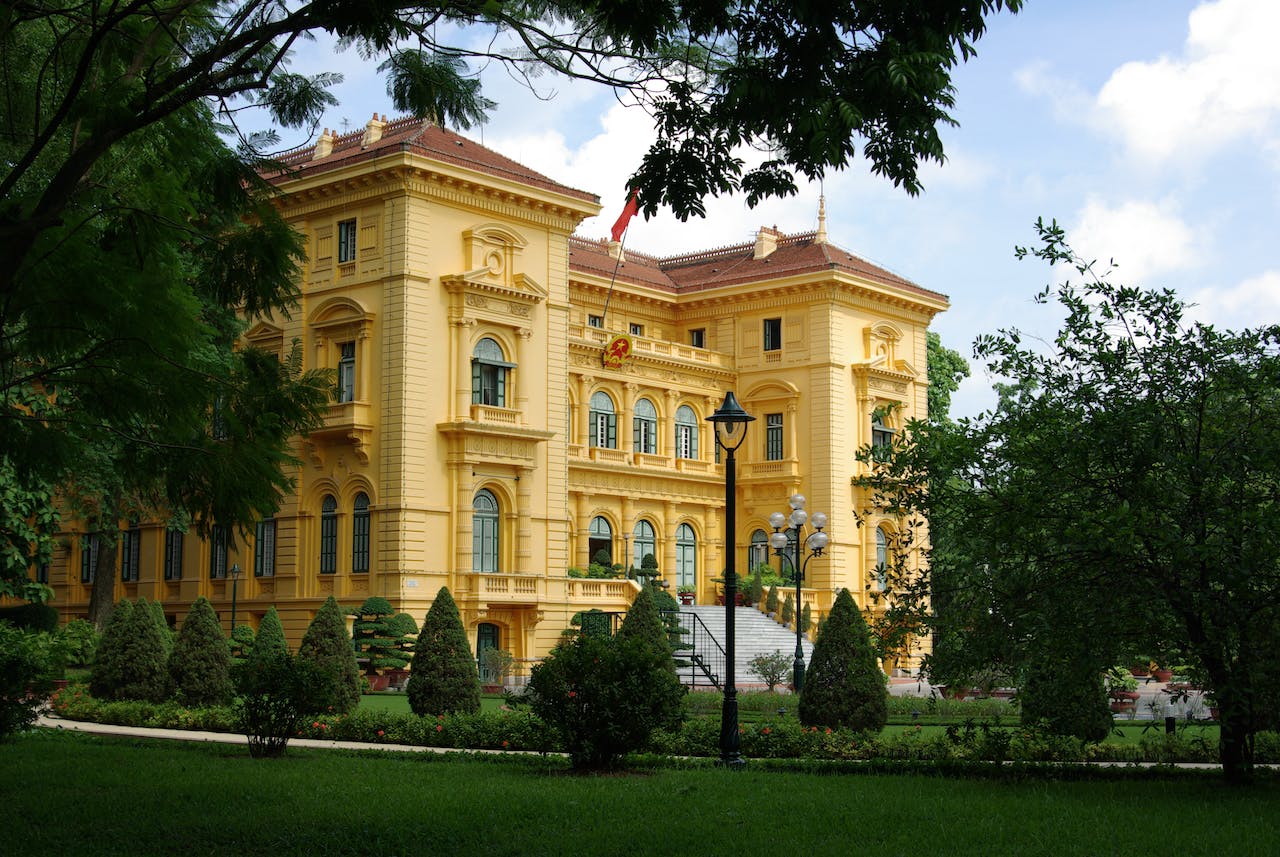Nestled amidst the lush greenery of the historical Ba Dinh Square in Hanoi, Vietnam, stands a magnificent edifice that has borne witness to the nation’s tumultuous history. The Presidential Palace, a striking symbol of power and political legacy, is a testament to the country’s journey from colonial rule to independence and reunification. In this article, we will explore the architectural and historical significance of the Presidential Palace, which has served as a residence for French colonial governors, the President of North Vietnam, and now as a vital site for visitors eager to delve into the nation’s past.
The Presidential Palace: A Glimpse into History
The Presidential Palace, or “Nha Bac Ho” in Vietnamese, is a majestic neoclassical structure that exudes an air of timeless elegance. This architectural gem is situated within the vast precincts of the Ba Dinh Square, surrounded by historic landmarks such as the Ho Chi Minh Mausoleum, the Ho Chi Minh Stilt House, and the One Pillar Pagoda. The palace’s architecture reflects the neoclassical style favored during the French colonial era, characterized by symmetrical design, columns, and grand façades.
Architectural Marvel: A Blend of East and West
The construction of the Presidential Palace began in 1900 and was completed in 1906 under the French colonial administration. Its grandeur and stately architecture were intended to reflect the might of the French colonial rule in Indochina. The palace was designed by the French architect Auguste Henri Vildieu, who incorporated both Western and Eastern architectural elements into the design.
One of the most striking features of the palace is its distinct yellow façade. The choice of color, reminiscent of traditional Vietnamese architecture, demonstrates a harmonious blend of Eastern and Western design influences. Additionally, the palace boasts colonial architectural elements such as grand pillars, spacious verandas, and wrought-iron railings, which are prevalent in the European neoclassical style.
A Historic Residence: French Colonial Governors
The Presidential Palace initially served as the official residence of the French colonial governors in Vietnam during the colonial era. It was built to house the highest-ranking French officials, including the Governor-General of Indochina. Its grandeur was a reflection of the power wielded by the colonial administrators in their quest to exert control over the Vietnamese population.
The French colonial governors occupied the palace for several decades, using it as a symbol of their authority. It was here that important decisions were made, policies enacted, and the French colonial legacy in Vietnam was managed.
A Witness to Vietnam’s Quest for Independence
The most significant historical moment associated with the Presidential Palace is its role during Vietnam’s struggle for independence. It was at this imposing residence that President Ho Chi Minh, the revered leader of the Vietnamese communist revolution, chose to reside and work during his time in Hanoi. Ho Chi Minh, often referred to as “Uncle Ho,” played a pivotal role in the fight for national liberation against French colonial rule and later in the conflict against the United States during the Vietnam War.
The Presidential Palace, once a symbol of French colonial authority, now stood as the home of the man who would lead Vietnam to independence. This transformation of purpose marked a significant turning point in the nation’s history.

Historical Significance: Meetings and Agreements
During its storied history, the Presidential Palace witnessed several crucial events and diplomatic meetings. One of the most notable of these meetings was the Geneva Conference of 1954, which resulted in the signing of the Geneva Accords. The accords led to the temporary division of Vietnam along the 17th parallel, with the promise of national elections in 1956 to determine the country’s reunification. The division ultimately led to the Vietnam War, which raged for nearly two decades.
The conference was held in the ornate yellow drawing room of the Presidential Palace, and its agreements marked a significant chapter in the nation’s history. Despite the partition, the palace played a role in setting the stage for future discussions on the reunification of North and South Vietnam.
Presidential Residence: Ho Chi Minh’s Time at the Palace
After the Geneva Accords, Ho Chi Minh decided to live in the Presidential Palace, making it his official residence from 1954 until his death in 1969. Ho Chi Minh’s presence in the palace was a powerful symbol of the Vietnamese government’s authority in the North, as well as its commitment to the struggle for reunification and independence.
The stilt house located within the palace grounds served as Ho Chi Minh’s residence. This simple, traditional wooden dwelling is in stark contrast to the grandeur of the main palace building. The stilt house is now preserved as a museum, allowing visitors to glimpse into the modest life of the revolutionary leader.
A Living Museum: The Presidential Palace Today
The Presidential Palace is not only a historical site but also a living museum that offers visitors a unique opportunity to explore Vietnam’s history. While the palace itself is not open to the public, the surrounding grounds and buildings provide a captivating glimpse into the nation’s past.
- Ho Chi Minh Stilt House: The stilt house where President Ho Chi Minh lived and worked is a prominent attraction within the palace complex. Visitors can explore the living quarters and office of the beloved leader. The simple furnishings and personal items provide insight into Ho Chi Minh’s daily life.
- Gardens and Grounds: The palace is surrounded by beautifully landscaped gardens and walkways. Visitors can stroll through the lush greenery, enjoying the serenity and natural beauty of the site.
- Ceremonial Hall: The palace complex also houses a Ceremonial Hall that was used for official functions and meetings. While not open for public entry, its elegant exterior is worth admiring.
- Guards and Ceremonies: The palace is guarded by a regiment of soldiers in pristine white uniforms. Visitors can observe the changing of the guards and participate in the solemn flag-lowering ceremony.
Visiting the Presidential Palace: Practical Information
If you plan to visit the Presidential Palace and its surrounding historical sites, here are some practical details to keep in mind:
- Location: The Presidential Palace is located in Ba Dinh Square, Hanoi, Vietnam.
- Opening Hours: The grounds are generally open to the public, and visiting hours may vary. It’s advisable to check the opening hours before planning your visit.
- Dress Code: Visitors should dress modestly when exploring the palace complex. Modest attire, covering shoulders and knees, is recommended as a sign of respect.
- Photography: Photography is generally permitted in most areas of the palace complex. However, there may be restrictions in some indoor locations.
- Ticketing: Visitors may need to purchase tickets to access certain areas, such as the Ho Chi Minh Stilt House and museum.
A Monument to Vietnam’s Past and Future
The Presidential Palace in Hanoi is more than just a stately building; it is a living testament to the enduring spirit of a nation that has overcome colonialism, war, and division. It reflects the rich tapestry of Vietnam’s history, from its colonial past to its struggle for independence and reunification.
The Presidential Palace complex invites visitors to walk in the footsteps of leaders, to explore the life of Ho Chi Minh, and to witness the changing of the guards, all while surrounded by serene gardens and historical relics. It stands as a powerful symbol of the resilience and determination of the Vietnamese people, a reminder of the sacrifices made to achieve independence, and an enduring beacon of hope for the future.
As you explore the grounds and visit the stilt house, you can’t help but feel the weight of history and the sense of reverence for the past. The Presidential Palace embodies the dreams and aspirations of a nation that endured hardship and conflict, and it continues to inspire new generations to uphold the principles of unity, independence, and freedom that have defined Vietnam’s journey over the centuries.
Featured Image & Source: Presidential Palace in Hanoi, Vietnam | Photo by 라스 해
Read more Vietnam travel articles.

